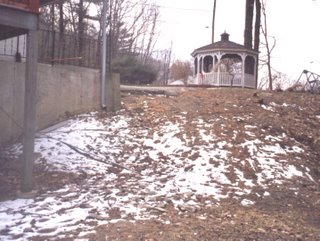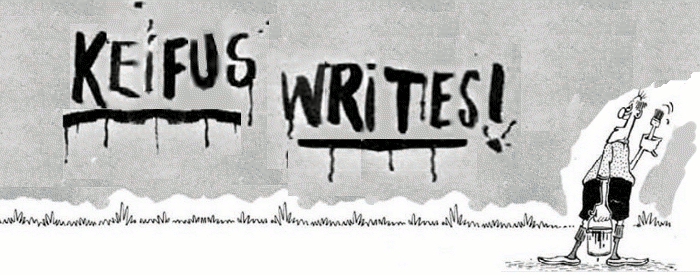The Railroad's Final Legacy (Recycled, with Pictures!)
Well switters, you inspired this one. I was motivated enough to recycle, not enough to create. I've been meaning to do this post-with-photos experiment for a while now.

There's a long history of re-use of building materials from civilizations past. Those civilizations that laid down the best architecture were primo sources for new buildings when they finally left town. Excavated Roman ruins, for example, routinely show signs of theft, with their masonry subsequently cobbled together to form later, and presumably lesser, British churches, manor homes, and so forth. Not just British, of course (though the Brits seem rather fond of their archaeological history), but in all places where the Powers That Be passed on to become Powers That Ain't. Clever archaeologists find useful information in the evidence of this theft, but who can condemn the robbers for extracting value from the bones of an old oppressor, built on the labor of their ancestors? That is, in those cases where it wasn't scavenged at the whim of some new overlord.
We Americans lack the lengthy architectural legacies of civilization-rich Europe or Asia or North Africa. Here, "old" is measured in terms of a scant couple centuries, not millenia. With no majestic ruins of Rome to absorb, our modern plunder comes from times less grand, from the dirty, smoky industrial revolution when New England forests, unsacred, were cut down wholesale to make way for belching mills and marginal farms, muddy roads winding through stump-filled downtowns. (Now it's all prime real estate, and barn board, if you can find it, is valuable.) The American prairie was profaned with the same vigor, and through it all, the Railroad rises to the top as the symbol of the fervid economic and geographic expansion of that time. When the new empire of highways took the stage and kicked that grimy, magisterial old enterprise upstairs, we plebes were left to plunder its architectural riches for our own lowly purposes. The prime construction material looted from that age is one that fits befits its beauty and permanence: the railroad tie.
I'm going somewhere with this. Your Keifus is constructing a retaining wall and stairs out of the things, building up the gravelly bank separating the front and back of halves of my puny yard. With two full years of successful procrastination behind me, the tarry ziggurat is finally nearing completion. This is a rant.
You can buy "landscape timbers" from your local Home Cheapo, but please don't confuse them with railroad ties. Unlike the genuine article, the carefully named timbers are regularly-shaped, lightweight, and expensive. They are used only by smart, sane people with deep wallets—the unproud kind of people that would instinctively hire contractors for this sort of thing. On the other hand, your typical railroad tie is a monster. It's about seven by nine by a hundred inches long, give or take a lot, and soaked with creosote to delay rotting. They cost just over ten bucks apiece, about half the price per unit wall height than those wussy hardware store jobs, which is why I bought them. At that size and that level of infiltration with sticky black goo, each one weighs about 200 pounds or more, depending on how long it's been raining. If you've somehow found "new" railroad ties and want to commisserate, save it, because anything that hasn't survived twenty years of locomotive traffic isn't fit to hold back my fill.
Each of these beasts is usually heavily damaged on at least two sides, in danger of splitting along its entire length, tremendously heavy, hiding chunks of metal or stone, not quite regularly shaped, and filled with tar that makes your tools dull and dirty in no time. Stacking them together requires cutting (a chain saw is best), lugging and lifting (more managable when cut), leveling (good luck!), drilling ten inches deep holes (did I mention the dulling effects?), and pounding in feet and feet of rebar with a hand sledge through recalcitrant logs and rocky earth (I feel like a sweaty Vulcan at one of his less glamorous gigs). You eventually get a knack
for picking only the good sides for exposure and identifying which ends can be hidden into the earth for...satisfactory results.
Why only satisfactory? Because for all that painstaking effort and physical expenditure, you still can't really get past the fact that you've just made a big pile of nasty old used railroad ties. God bless that enterprising human spirit!
Addendum: Grand introduction notwithstanding, railroad ties last about 20 years. My supply no doubt comes from maintenance on existing modern rail lines. They are now making ties out of recycled plastic waste. No doubt these will be a valuable source of polymer in some future where petroleum is dethroned.
Addendum2, Cost:
about 50 nasty, tarry, ties at $11/ea
about 300 linear feet of rebar at $0.10/ft
about 3 hammer handles at $6/ea
about 10 yards of dirt at $15/yd
about 10 shrubs at $30/ea
drainage pipe, storm drain, and concrete at $50
about 3 yards of mulch at $20/yd
sweat, pain, & satisfaction for my big pile of lincoln logs?
--um, about $1158.


There's a long history of re-use of building materials from civilizations past. Those civilizations that laid down the best architecture were primo sources for new buildings when they finally left town. Excavated Roman ruins, for example, routinely show signs of theft, with their masonry subsequently cobbled together to form later, and presumably lesser, British churches, manor homes, and so forth. Not just British, of course (though the Brits seem rather fond of their archaeological history), but in all places where the Powers That Be passed on to become Powers That Ain't. Clever archaeologists find useful information in the evidence of this theft, but who can condemn the robbers for extracting value from the bones of an old oppressor, built on the labor of their ancestors? That is, in those cases where it wasn't scavenged at the whim of some new overlord.
We Americans lack the lengthy architectural legacies of civilization-rich Europe or Asia or North Africa. Here, "old" is measured in terms of a scant couple centuries, not millenia. With no majestic ruins of Rome to absorb, our modern plunder comes from times less grand, from the dirty, smoky industrial revolution when New England forests, unsacred, were cut down wholesale to make way for belching mills and marginal farms, muddy roads winding through stump-filled downtowns. (Now it's all prime real estate, and barn board, if you can find it, is valuable.) The American prairie was profaned with the same vigor, and through it all, the Railroad rises to the top as the symbol of the fervid economic and geographic expansion of that time. When the new empire of highways took the stage and kicked that grimy, magisterial old enterprise upstairs, we plebes were left to plunder its architectural riches for our own lowly purposes. The prime construction material looted from that age is one that fits befits its beauty and permanence: the railroad tie.
I'm going somewhere with this. Your Keifus is constructing a retaining wall and stairs out of the things, building up the gravelly bank separating the front and back of halves of my puny yard. With two full years of successful procrastination behind me, the tarry ziggurat is finally nearing completion. This is a rant.
You can buy "landscape timbers" from your local Home Cheapo, but please don't confuse them with railroad ties. Unlike the genuine article, the carefully named timbers are regularly-shaped, lightweight, and expensive. They are used only by smart, sane people with deep wallets—the unproud kind of people that would instinctively hire contractors for this sort of thing. On the other hand, your typical railroad tie is a monster. It's about seven by nine by a hundred inches long, give or take a lot, and soaked with creosote to delay rotting. They cost just over ten bucks apiece, about half the price per unit wall height than those wussy hardware store jobs, which is why I bought them. At that size and that level of infiltration with sticky black goo, each one weighs about 200 pounds or more, depending on how long it's been raining. If you've somehow found "new" railroad ties and want to commisserate, save it, because anything that hasn't survived twenty years of locomotive traffic isn't fit to hold back my fill.
Each of these beasts is usually heavily damaged on at least two sides, in danger of splitting along its entire length, tremendously heavy, hiding chunks of metal or stone, not quite regularly shaped, and filled with tar that makes your tools dull and dirty in no time. Stacking them together requires cutting (a chain saw is best), lugging and lifting (more managable when cut), leveling (good luck!), drilling ten inches deep holes (did I mention the dulling effects?), and pounding in feet and feet of rebar with a hand sledge through recalcitrant logs and rocky earth (I feel like a sweaty Vulcan at one of his less glamorous gigs). You eventually get a knack
for picking only the good sides for exposure and identifying which ends can be hidden into the earth for...satisfactory results.
Why only satisfactory? Because for all that painstaking effort and physical expenditure, you still can't really get past the fact that you've just made a big pile of nasty old used railroad ties. God bless that enterprising human spirit!
Addendum: Grand introduction notwithstanding, railroad ties last about 20 years. My supply no doubt comes from maintenance on existing modern rail lines. They are now making ties out of recycled plastic waste. No doubt these will be a valuable source of polymer in some future where petroleum is dethroned.
Addendum2, Cost:
--um, about $1158.


2 comments:
Wow Keith,
This is exquisitely rendered and not alone for the bookends of the photographic evidence, ala W.G. Sebald, but because of the cultured and historical amplification.
You are a marvel.
John
I wrote it about a year ago, when I finished with the logs. This spring, I filled in the dirt and did the landscaping.
But yeah, I meant to see how annoying the photos were to add (answer: only a little), but hadn't felt much like trying to find the "before" picture.
Thanks for exaggerating.
K
Post a Comment